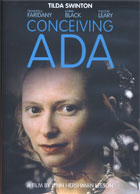
Conceiving Ada 2010
Distributed by Microcinema International/Microcinema DVD, 1636 Bush St., Suite #2, SF, CA 94109; 415-447-9750
Produced by Lynn Hershman Leeson
Directed by Lynn Hershman Leeson
DVD, color, 85 min.
College - Adult
Computer Science, Gender Studies, Media Studies, Science Fiction, Technology, Women's Studies
Date Entered: 12/02/2010
Reviewed by Linda Frederiksen, Washington State University, Vancouver, WAIn her first feature-length film, produced in 1997, feminist and award-winning media artist Lynn Hershman Leeson explores the relationship between women and technology. Conceiving Ada is an unusual film by any standards. Emmy, a young American computer scientist studying artificial life discovers a programming code that allows her to communicate directly with Lady Ada Lovelace, played by Tilda Swinton. Ada, the Victorian-era daughter of the poet Lord Byron, was a mathematician in her own right whose interest in encryption led to her authorship of the first computer algorithm, used in Charles Babbage’s “decision engine.” When Emmy succeeds in breaking the code to the past, she sees how Ada’s life parallels her own and plays itself out.
Using blue screen technology, the actors perform in virtual sets that consciously seek to blur the line between real and conceptual spaces. This experimental visual technique and decidedly non-linear narrative, along with cameo appearances by popular culture icons Timothy Leary, Karen Black and John Perry Barlow, give the film a psychedelic effect reminiscent of cult classics from the early 1970s. Similarly, the writing, acting and other special effects are intentionally free of the expected elements of more polished, slickly produced big budget science fiction films. Bonus features include a theatrical trailer, a short video on the making of the film and an extended discussion with the Leeson and Swinton that was recorded in 2009.
The work is unique in both concept and presentation and will not appeal to all audiences. It is recommended for academic and general audiences looking for a distinctly different film experience.